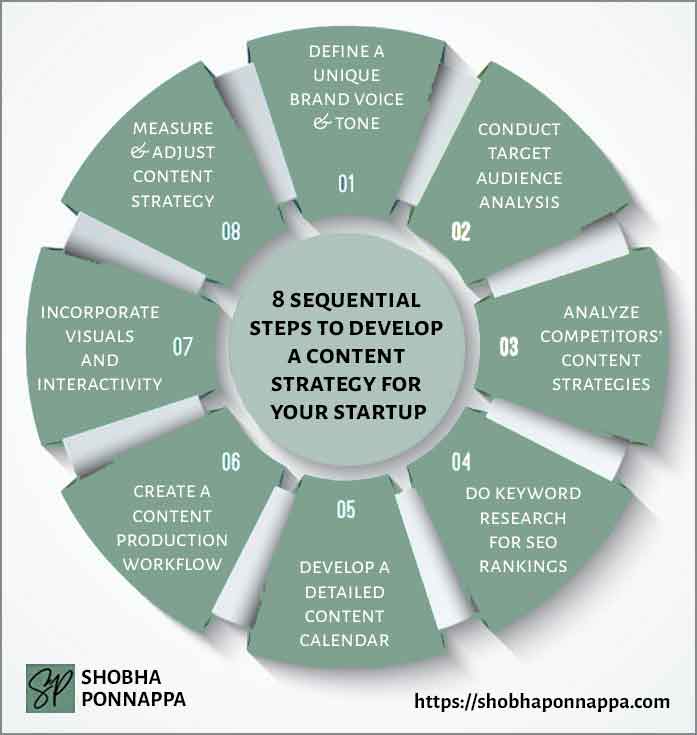
In the digital age, where every startup competes for attention, the right content can be the beacon that guides your audience to your brand.
Crafting a strategy that captures and retains this attention is no small feat; it demands a blend of creativity, market understanding, and data-driven insights.
To truly stand out, a startup must weave together traditional approaches with innovative tactics. This means not only following time-tested practices but also daring to incorporate unique, unexpected elements into your content strategy.
Such a blend ensures your brand not only reaches its audience but also resonates with them on a deeper level, setting the foundation for lasting engagement and loyalty.
To develop a startup content strategy that stands out, blending proven methods with unconventional ideas is not just advisable; it’s essential. This approach embodies the “Unusual By Strategy” forte, a unique blend of traditional and innovative tactics tailored to cut through the noise in today’s saturated digital landscape. For instance, leveraging SEO and analytics to guide content creation is a staple, yet integrating interactive elements like AR experiences or gamified content can dramatically enhance engagement and memorability. User-generated content and testimonials harness the power of community and authenticity, while exploring untapped platforms or experimental content formats can uncover new audience segments. Strategic partnerships with influencers or brands from non-competing industries offer fresh perspectives and cross-promotional opportunities. This dual approach ensures that startups not only reach their target audience through tried-and-true channels but also captivate and retain them by pushing the boundaries of what content can achieve, aligning perfectly with a mandate to deliver strategies that are as effective as they are unexpected.
To develop a startup content strategy that stands out, blending proven methods with unconventional ideas is not just advisable; it’s essential. This approach embodies my “Unusual By Strategy” forte, a unique blend of traditional and innovative tactics tailored to cut through the noise in today’s saturated digital landscape.
For instance, leveraging SEO and analytics to guide content creation is a staple, yet integrating interactive elements like AR experiences or gamified content can dramatically enhance engagement and memorability. User-generated content and testimonials harness the power of community and authenticity, while exploring untapped platforms or experimental content formats can uncover new audience segments.
Strategic partnerships with influencers or brands from non-competing industries offer fresh perspectives and cross-promotional opportunities.
This dual approach ensures that startups not only reach their target audience through tried-and-true channels but also captivate and retain them by pushing the boundaries of what content can achieve, aligning perfectly with a mandate to deliver strategies that are as effective as they are unexpected.
Leveraging my 40+ years’ experience as a Brand Content Strategist with a penchant for the unusual, I’ve outlined 8 ideas below that meld time-tested approaches with innovative twists for developing an impactful content strategy for startups. These ideas are crafted to not only harness the proven power of traditional content marketing techniques but also incorporate unique, unconventional elements.
This combination ensures startups can capture their audience’s attention in the crowded digital space, establishing a distinctive brand presence. By integrating these unusual twists, content strategies work even harder, ensuring startups not only reach but resonate deeply with their target audiences, fostering engagement, loyalty, and growth.

Crafting a distinctive brand voice and tone is akin to giving your startup its own personality, crucial for standing out in a sea of content and forming genuine connections with your audience.
This foundational element of content marketing not only guides the style and approach of your messaging across all platforms but also ensures consistency, which is key to building trust and recognition. Consider a startup in the sustainable fashion industry that adopts a playful yet informative tone, using engaging storytelling to highlight the impact of fast fashion on the environment.
Through blog posts, social media, and email campaigns, they weave this narrative consistently, making complex information accessible and engaging. This approach not only educates their audience but also aligns perfectly with their brand values, demonstrating their commitment to sustainability and transparency.
By establishing such a voice, they effectively differentiate themselves from competitors, making their content a go-to resource for consumers seeking to make more environmentally friendly fashion choices, thereby driving brand loyalty and customer engagement.

Consider the idea of “Dynamic Tone Shifting.” This unusual enhancement involves deliberately adjusting your brand’s tone in response to current events, trends, or audience mood, without losing the core identity of your voice. It’s about being adaptable and showing that your brand is in tune with the world around it.
For the sustainable fashion startup, this could mean adopting a more serious and educational tone during environmental crises, or a celebratory and optimistic tone during sustainability milestones. By dynamically shifting the tone, the startup remains relevant and empathetic, deepening its connection with the audience by reflecting their concerns and joys, thus enhancing engagement and loyalty.
Understanding your target audience is crucial for tailoring a content strategy that resonates deeply, driving engagement and conversion. This process involves gathering insights on demographics, interests, behaviors, and pain points through surveys, social media analysis, and direct feedback.
For a tech startup focusing on productivity tools, conducting audience analysis might reveal that their potential users are not just corporate employees, but also freelancers and small business owners craving efficiency. This discovery allows the startup to diversify its content, offering tips, hacks, and success stories relevant to each subgroup.
By segmenting their audience and creating content that speaks directly to the specific needs and challenges of each segment, the startup can enhance its relevance and appeal.
Such targeted content marketing efforts ensure the message hits home, fostering a stronger connection with the audience and ultimately guiding them down the conversion funnel more effectively.

Consider the idea of “Narrative Immersion Research.” This unusual enhancement takes target audience analysis beyond traditional methods by immersing into the environments and narratives of your audience’s daily lives. It involves participating in or observing the communities, forums, and events where your audience is active, capturing their stories and experiences firsthand.
For the tech startup focused on productivity tools, this could mean joining freelancer forums, attending small business workshops, or using social listening tools to capture real conversations about work challenges. By engaging directly with these environments, the startup gains a nuanced understanding of its audience’s needs, enabling the creation of highly personalized and relevant content that feels tailor-made for each segment, thus significantly boosting engagement and loyalty.
Analyzing competitors’ content strategies equips startups with insights to refine their own approach, identifying what resonates with the target market and uncovering gaps to exploit.
This involves scrutinizing the type of content they produce, the channels they prioritize, their engagement levels, and how they position themselves in the market. For a startup specializing in eco-friendly packaging, examining competitors might reveal a lack of content addressing the lifecycle analysis of packaging materials.
By filling this gap with detailed blog posts, infographics, and videos that educate their audience about the environmental impact of various packaging options, the startup not only distinguishes itself as a thought leader but also captures the interest of a niche yet highly engaged audience segment.
This strategic move not only elevates their content strategy but also directly contributes to a stronger brand presence and increased customer loyalty, by aligning closely with the values and interests of their target audience.

Consider the idea of “Reverse Engineering Engagement.” This unusual enhancement involves not just analyzing the content your competitors produce but diving deeper into the audience’s reactions to it. By examining comments, shares, and discussions across platforms, you can uncover the emotional triggers and specific elements that lead to high engagement.
For the eco-friendly packaging startup, applying this method could reveal that competitors’ content often misses sparking a dialogue about the emotional impact of sustainable living. By creating content that encourages personal stories and discussions about the changes individuals are making for a healthier planet, the startup can foster a more engaged community, setting their content strategy apart with a focus on emotional connectivity and community building.
Keyword research for SEO rankings is a critical step for startups aiming to enhance their visibility and attract targeted traffic. This process involves identifying terms and phrases your target audience uses when searching for products or services like yours.
By integrating these keywords into your content, you improve your chances of ranking higher in search engine results, making it easier for potential customers to find you. For example, a startup offering vegan skincare products would benefit from researching keywords related to vegan beauty, cruelty-free skincare, and eco-friendly cosmetics.
Incorporating these keywords into their blog posts, product descriptions, and meta tags not only optimizes their content for search engines but also ensures they are reaching consumers who are actively interested in their niche.
This strategic approach to keyword research and SEO enables startups to drive more organic traffic, enhance user engagement, and increase conversions, thereby leveraging the power of content marketing to fuel their growth.

Consider the idea of “Semantic Expansion Technique.” This unusual enhancement broadens traditional keyword research by integrating semantically related terms and concepts, leveraging the power of latent semantic indexing (LSI) to enhance SEO performance. Beyond focusing on direct keywords like “vegan skincare products,” this approach involves identifying and incorporating related terms, synonyms, and topics that enrich content contextually.
For the vegan skincare startup, incorporating terms such as “plant-based skincare benefits,” “eco-friendly beauty routines,” or “cruelty-free skincare ingredients” can significantly widen the net for capturing relevant search queries. This technique not only boosts SEO rankings by aligning with search engines’ sophisticated algorithms but also enriches content value for readers, offering comprehensive insights that cater to a broader array of consumer interests and queries.
Developing a detailed content calendar is a strategic approach that ensures consistency, relevance, and timely engagement with your audience. This planning tool allows startups to map out content publication across different platforms, ensuring a balanced mix of topics, formats, and themes that resonate with their target audience.
For a startup in the health and wellness space, for example, a content calendar might highlight seasonal trends, like focusing on immunity-boosting tips during flu season or hydration strategies in summer.
By planning this content in advance, the startup can capitalize on timely topics, distribute its marketing efforts evenly, and align content with product launches or promotional campaigns.
This foresight not only helps in maintaining a steady stream of content to keep the audience engaged but also allows for flexibility to adapt to unforeseen events or trends, ensuring the content strategy remains dynamic and responsive to audience needs and interests.

Consider the idea of “Audience-Directed Content Planning.” This unusual enhancement involves directly involving your audience in the content planning process, making them active participants in deciding some of the topics or types of content you create. For the health and wellness startup, this could mean running polls on social media platforms asking followers whether they’re more interested in nutritional advice, workout tips, or mental wellness strategies for upcoming content.
This approach not only ensures that your content calendar is aligned with real-time audience interests and needs but also significantly boosts engagement by making your audience feel valued and heard. Incorporating their preferences ensures your content remains relevant, dynamic, and deeply connected to your community’s evolving interests.
Creating a content production workflow is essential for streamlining the process of content creation, ensuring each piece is developed efficiently and meets quality standards.
This structured approach involves defining the stages of content creation, from ideation and research to writing, editing, approval, and publication, assigning specific roles and deadlines at each step. For a startup focused on sustainable living, the workflow might begin with brainstorming sessions to generate content ideas that align with sustainability trends.
Then, tasks are assigned to team members with expertise in research, writing, and graphic design to create comprehensive blog posts and accompanying visuals. An editing and review phase follows, ensuring accuracy and adherence to brand voice.
Finally, the content is scheduled for publication and promotion across selected platforms. This workflow not only maximizes productivity but also fosters collaboration and consistency, allowing the startup to maintain a steady flow of high-quality content that engages and educates its audience on sustainable practices.

Consider the idea of “Gamified Content Creation.” This unusual enhancement introduces elements of competition and reward into the content production workflow to boost motivation and productivity among team members. In the context of the sustainable living startup, this could mean setting up challenges for generating the most innovative content ideas or rewarding the team for meeting tight deadlines.
Each phase of the workflow could have milestones, with rewards for achieving them, such as public recognition, small bonuses, or additional time off. This approach not only makes the content creation process more engaging and fun but also encourages creativity and teamwork, leading to higher-quality content and a more cohesive brand message.
Incorporating visuals and interactivity into your content strategy significantly enhances user engagement and retention. Visual elements like images, infographics, and videos can break down complex information, making it more accessible and memorable for your audience.
Interactive content, such as quizzes, polls, and interactive infographics, further engages users by encouraging participation and personalization of their experience. For example, a startup focusing on healthy eating could leverage an interactive quiz to help users identify their nutritional needs based on lifestyle and preferences, followed by personalized meal recommendations.
This not only provides value to the user but also increases the time spent on the site, boosts social sharing, and gathers valuable data on user preferences.
By making content more dynamic and visually appealing, startups can better capture attention in the crowded digital space, foster deeper connections with their audience, and drive higher conversion rates.

Consider the idea of “Dynamic Story Mapping.” This enhancement reimagines content interactivity by allowing users to navigate their own journey through your content. Instead of a linear path, users can choose different storylines or topics based on their interests, creating a unique, personalized experience.
For the healthy eating startup, this could translate into an interactive “Choose Your Food Adventure” map where users select dietary preferences, health goals, or culinary curiosity to explore tailored content, recipes, and nutrition tips. This method not only makes the user experience more engaging but also provides valuable insights into user preferences, allowing for more targeted and effective content in the future.
Measuring and adjusting your content strategy is critical to ensure its effectiveness and alignment with your startup’s goals. This continuous process involves analyzing data on user engagement, such as page views, bounce rates, social shares, and conversion rates, to identify what content resonates most with your audience.
For instance, a startup in the eco-friendly products space might discover that their how-to guides on sustainable living practices outperform other content types in terms of engagement and conversions.
Armed with this insight, the startup can adjust its content calendar to produce more of these guides, experiment with different topics within the sustainability realm, and allocate more resources to promote them across channels.
Regularly revisiting and refining your content strategy based on concrete data allows for agile responses to audience preferences and market trends, optimizing your content’s impact and ensuring your startup’s message reaches and engages the right audience.

Consider the idea of “Sentiment-Driven Strategy Refinement.” This enhancement goes beyond traditional metrics, delving into the emotional reactions and sentiments your content evokes within your audience. Utilizing sentiment analysis tools and natural language processing (NLP) technologies, you can gauge the mood, emotions, and attitudes expressed in comments, social media interactions, and feedback related to your content.
For the eco-friendly products startup, applying sentiment analysis could reveal not just how many people are engaging with their sustainable living guides, but how these guides make them feel – inspired, motivated, or even overwhelmed. This deeper understanding allows for fine-tuning content to better align with audience emotions, potentially leading to stronger connections and more impactful engagements.
Define your unique brand voice and tone: Establishing a distinct voice and tone for your brand is crucial for differentiating your startup in a crowded market. It ensures consistency across your content, making your brand more recognizable and relatable to your audience.
Incorporate visuals and interactivity: Visual and interactive elements not only enrich the user experience but also significantly increase engagement and retention. These elements make complex information more accessible and encourage active participation from your audience.
Measure and adjust content strategy: Continuous monitoring and adjustment of your content strategy based on performance data and audience feedback are essential for its success. This agile approach allows you to refine your strategy over time, ensuring it remains effective and aligned with your audience’s evolving needs and preferences.

"As a Content/Brand Specialist, and SEO/UX Writer, I can help transform your brand's online presence. I can lift it with innovative ideas to take it to an enviable position. Let's collaborate to create a captivating brand story, engage your audience, boost your online visibility, and increase your ROI. Take the next step towards your brand content success and contact me today."
Shobha Ponnappa
I Bring You:
Content Marketing That’s “Unusual By Strategy” … Tips, Tricks, Tactics, Techniques, Trends, Training.
Get my weekly ContenTracker Newsletter packed with loads of content marketing ideas – proven and unusual.
Get a free download of my ebook on “50 Unusual Ways To Use AI In Content Marketing” … and transform your success.

Just fill in the form to join my community … we have big and small brands for company. You’ll stay on the speedway to growth.
KEY TOPIC CATEGORIES COVERED ON THIS SITE:
COPYRIGHT © 2025. SHOBHAPONNAPPA.COM. ALL RIGHTS RESERVED.

Just fill in this form and get this awesome guide via email. Plus … each fortnight you’ll receive my Brand Reframe Newsletter that brings you smart insights, distilled thinking, and focused brand momentum.